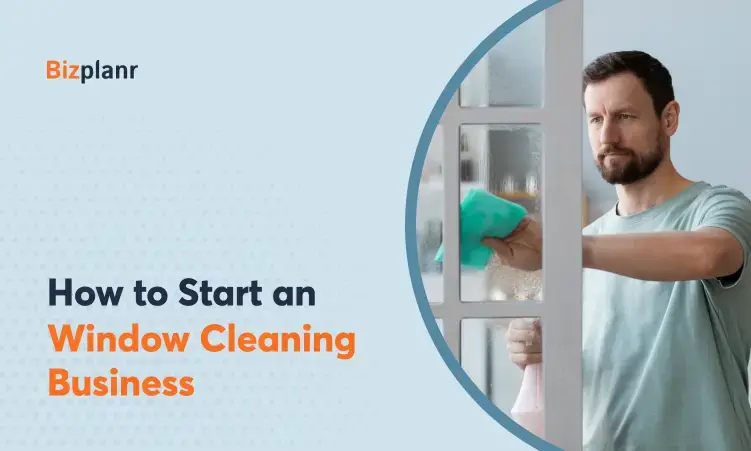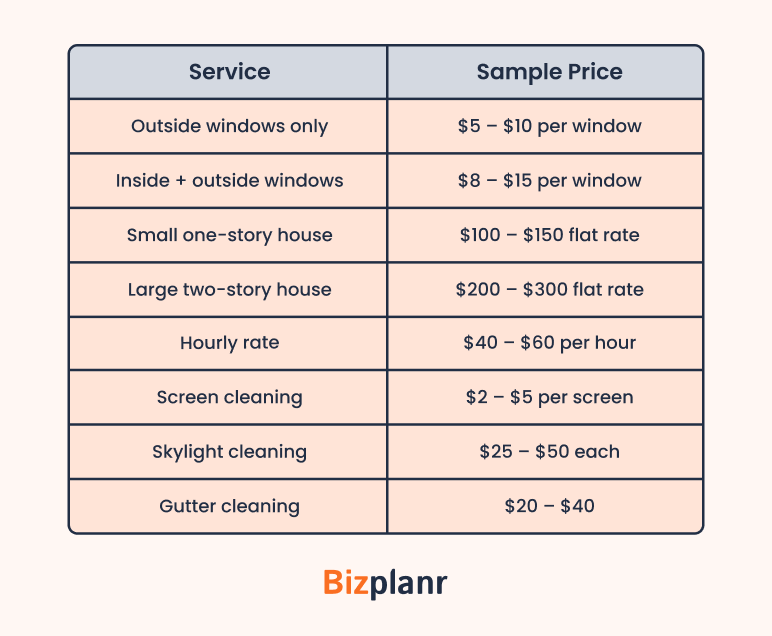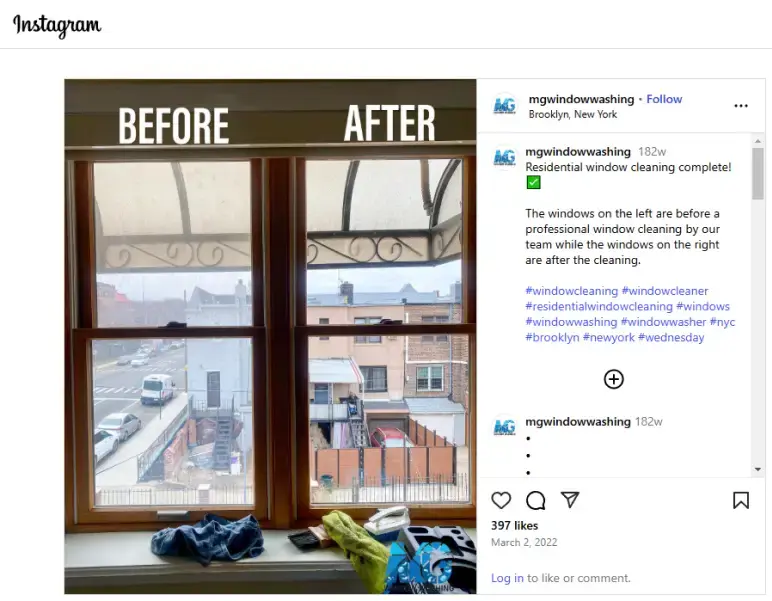Starting a window cleaning business is easier than it seems. People always need clean windows—at homes, shops, and offices—but most don’t want to clean them. That’s where you can step in. You only need a few basic tools, some effort, and good service to get started.
The key is knowing how to begin. You’ll learn how to find your first clients, set fair prices, and do a good job so people call you again. Small jobs can grow into steady work over time.
This guide will show you step by step how to start a window cleaning business. From getting tools to finding clients, building trust, and adding extra services, everything is explained in simple words so you can start confidently and grow.
Key Takeaways
- You can start with a small budget of about $600–$1,500 if you already have a car.
- Check local cleaners to set fair prices.
- Use simple marketing like flyers, social media, and Google Profile.
- Give good service so customers call you again and tell others.
Step 1: Decide on your window cleaning services
Before you start, ask yourself: Who do you want to clean windows for? Houses, shops, or tall buildings? Do you want easy jobs or harder ones?
These questions will help you choose the type of window cleaning. Different jobs need different tools and skills. When you know what you want, it is easier to buy tools, set prices, and get customers.
Here are the main types of window cleaning:
| Service Type | What It Means | Why Pick It |
|---|---|---|
| Residential | Windows in houses or apartments | Easy to start, cheap tools, flexible work |
| Commercial | Offices, restaurants, or shops | Regular work, steady income |
| Storefronts | Glass fronts of small shops | Quick jobs, repeat work |
| High-Rise | Tall buildings | Pays more, but needs safety gear and training |
| Post-Construction | After building or repairs | Removes dust, paint, and dirt |
| Extras | Screens, skylights, gutters, solar panels | Earn more by adding services |
If you are new, start with houses or small shops. These jobs are safe, simple, and don’t need expensive tools. Later, you can grow your business and take bigger jobs like commercial or high-rise cleaning.
Step 2: Research your local market
Before you start your window cleaning business, it’s important to learn about your area. You need to see who might need your service and who else is already working there. This will help you plan better and get customers faster.
Begin by looking around your neighborhood. Notice the houses, offices, and shops, and think about how many windows may need cleaning.
The demand for window cleaning is also rising, with the global market expected to grow by about 4.8% each year through 2030. This shows more people are now hiring professionals instead of doing it themselves.
Also, pay attention to other cleaners near you. See how many other window cleaners are nearby, what services they offer, and how much they charge.
Talking to people is also helpful. Ask neighbors, friends, or local shop owners if they hire window cleaners and how often, as this will show you what people really need.
You can also search online to check local window cleaning businesses. Look at their prices and services to see what makes your service different.
Market research gives you a clear idea of the demand, helps you avoid mistakes, and shows you how to offer better service than others.
Start in areas with many houses or shops. More windows mean more potential clients and more jobs for you.
Step 3: Write a simple business plan
Have you ever tried going somewhere without a map? You might still reach, but it takes longer and feels confusing. The same is true for starting a business. A simple business plan works like your map. It shows you where to begin and how to grow your window cleaning business.
A cleaning business plan matters because it helps you stay clear. Without it, you may not know who to target, how much to charge, or how to get customers.
Writing things down makes it easier to follow and also easier to change later as you learn.
Here’s what to include in your plan:
- Services – Will you clean house windows, shop windows, or both? Will you also do extras like gutters or solar panels?
- Customers – Who will you serve? Homeowners, shops, offices, or a mix?
- Prices – How will you charge? Per window, per job, or per hour?
- Marketing – How will people know about you? Flyers, social media, friends, or Google Business Profile?
- Goals – What are your long-term goals? What are your short-term goals?
A short, clear plan keeps you on track and gives your business a strong start.
Get Your Business Plan Ready In Minutes
Answer a few questions, and AI will generate a detailed business plan.
Step 4: Budget your startup costs
Before you begin, you should know how much money you’ll need. A small budget helps you stay ready and not spend too much.
Here are the common things you may need and their rough costs:
| Item | What it includes | Rough Cost (USD) |
|---|---|---|
| Tools & supplies | Squeegees, buckets, scrubbers, towels, cleaning liquid, ladder | $200 – $500 |
| Safety gear | Gloves, harness, non-slip shoes | $50 – $150 |
| Transport | Use your own car (free) or buy a used van | $0 if you own / $3,000 – $6,000 if buying |
| Work clothes | Simple shirts or polos with your business name | $50 – $150 |
| Marketing | Flyers, business cards, simple website | $100 – $300 |
| Insurance & licenses | Business registration and liability insurance | $200 – $600 |
👉 If you already own a car, you can start for about $600–$1,500. If you also need to buy a van, then the costs go much higher.
How you’ll pay:
- Use personal savings if you want to start small.
- For bigger costs like a van, you can take a small loan or buy it later after earning money.
- Some people also use a credit card for marketing or tools, but it’s best to keep debt low.
Start with what you can afford. As your income grows, you can slowly buy better tools or more services.
Step 5: Register your business and get licenses
Once you decide on your services and plan your budget, the next step is to make your business official.
Start by choosing a name that fits your window cleaning business. You also need to decide the legal structure, whether you keep it simple as a sole owner or set it up in a way that gives you extra protection.
After that, apply for an identification number for your business. This number helps you open a business bank account and keep your personal and business money separate.
You should also check if your local area requires a license or permit. Some places ask every small business to have one, and if you’re working from home, you may also need a home-based business permit.
Finally, think about getting insurance. It shows clients you’re professional and gives you protection in case of accidents. Many businesses will only hire you if you can show proof of insurance.
By completing these steps, your business becomes official, trusted, and ready to serve customers.
Step 6: Buy your equipment and supplies
After you register your business, it’s time to get the tools and supplies you need. The right tools make cleaning easier and faster.
Here is what you need:
- Different sizes of squeegees to clean windows
- Scrubbers to remove dirt
- Buckets for water and cleaning solution
- Ladders to reach high windows
- Scraper with blade
- Window cleaning liquid (non-toxic)
- Soft cloths to wipe windows
- Sponges for scrubbing
- Gloves to protect your hands
- Long poles for high windows
- Safety gear if you work on tall buildings
- Bags or buckets to carry all your supplies
When you start, buy only the basic tools, but choose good-quality items. Good tools last longer and help you clean better.
You can buy extra or bigger tools later when your business grows. Make a simple list before buying so you don’t forget anything or spend too much.
Using the right tools and supplies, and keeping quality in mind, helps you do a great job. Clean, shiny windows make clients happy. When your work looks good, people will trust you and call you again.
Step 7: Set your pricing strategy
Now that you know your market and have your tools, the next step is to decide how much to charge for window cleaning. Setting the right price is important. If your price is too high, people may not call you. If it’s too low, you may not make enough money.
The best way to start is by looking at what other window cleaners in your area charge. This gives you an idea of the normal price. You don’t have to be the cheapest, but your price should be fair.
You can choose how to set your price:
- Per window – Charge for each window you clean.
- Per hour – Charge based on the time you work.
- Per job – Set a flat price for the whole house or building.
Here’s a simple example of pricing (just to give you an idea):
For small houses, you may charge less. For bigger houses or offices, you can charge more because they take more time and effort.
Always be clear with clients about what your price includes—inside, outside, or both. A fair and simple pricing strategy makes clients happy and helps you earn well.
Step 8: Build your brand and marketing plan
After you set your prices, let people know about your window cleaning business. This is called building your brand and making a marketing plan. Your brand is what makes people remember you.
Start with a name that is short and easy. You can also make a simple logo. Use the same name and logo everywhere—on flyers, social media, and even on your bucket or car. This makes you look more professional.
Now, share your services. Here are some easy ways:
- Make simple flyers and give them to neighbors or shops
- Post on free websites like Facebook or community groups
- Ask friends and family to tell others about you
- Add your business to Google Maps so people can find you quickly
Show people your work. Take photos of windows after cleaning and post them online. Clean and shiny windows will make people trust you. For example:
You don’t need to spend much money. Start small and grow slowly. Even talking politely to shop owners or neighbors can bring you your first job.
When people start to notice your name and see you do good work, your business will grow faster. A strong brand plus simple marketing means more windows to clean and more happy clients.
Step 9: Deliver great service and scale up
In the previous step, you worked on building your brand and marketing your business. Once that brings you your first clients, the next step is to give them the best service. This means coming on time, cleaning windows properly, and being polite.
If people are happy with your work, they’ll call you again. Many will also tell their friends and family, which brings you more clients without extra effort.
As you start getting more jobs, you can think about growing. In the beginning, you may work alone. But later, you might hire helpers to finish more work. If you hire, make sure to train them so they also do neat work and treat clients well.
You can also grow by adding new services. Some people may want you to clean gutters, do pressure washing, or clean solar panels. These extras can give you more income and make your business stronger.
Remember, growing takes time. First, focus on making every client happy. Once people trust you and you have steady jobs, you can slowly expand.
Step by step, your small window cleaning business can turn into a big and successful one.
5 Mistakes to avoid when starting a window cleaning business
Getting into window cleaning sounds simple, but the way you start makes a big difference. Many beginners trip over the same mistakes before they even land their first job.
1. Skipping research on demand
Many people buy tools and print cards without checking if there’s enough demand in their area. If the local market is already crowded, it’s harder to get customers. A little research saves wasted time and money.
2. Starting without insurance
Window cleaning looks low-risk, but accidents happen. A broken window or ladder fall can cost more than your first year’s income. Skipping insurance to save money is a common early mistake.
3. No clear pricing system
Some beginners make up prices on the spot. This confuses customers and can make you look unprofessional. Having a simple pricing list (per window, per hour, or per job) from the start avoids awkward talks.
4. Using personal gear instead of proper tools
Trying to start with household cloths, buckets, or step ladders often leads to poor results. These don’t last long and leave windows streaky. A basic starter set made for professionals is smarter, even if small at first.
5. Ignoring branding and first impression
Even a small business needs to look trustworthy. Many new cleaners start without a proper name, logo, or even a clean uniform. This makes it harder for customers to take you seriously.
Avoiding these mistakes helps you start strong. Do some research, get insurance, set fair prices, use good tools, and look professional. That’s all you need to begin on the right track.
Final thoughts
Starting a window cleaning business is a good and possible idea. You don’t need expensive tools—just basic supplies, hard work, and a simple plan. Choose what kind of windows you want to clean, learn about your area, and grow your business step by step.
The most important thing is to give excellent service. If customers are happy, they’ll hire you again, leave nice reviews, and tell their friends. This will bring you more jobs and help your business grow.
Remember, every window cleaner begins small. With patience, good service, and helpful tools like Bizplanr.ai, which guides you to make a simple business plan and keep your goals clear, you can stay focused and grow with confidence.
Your first client might be very close, and each job you do will take you closer to building a strong and successful window cleaning business.
Get Your Business Plan Ready In Minutes
Answer a few questions, and AI will generate a detailed business plan.
Frequently Asked Questions
How much money do I need to start a window cleaning business?
If you already have a car, you can start with about $600–$1,500. This covers tools, supplies, and a ladder to begin working. If you also need to buy a vehicle, the cost will be much higher.
Do I need insurance for a window cleaning business?
It may not be required everywhere, but it’s very helpful. Insurance protects you if something breaks or if an accident happens. It also makes customers trust you more.
How do I find my first window cleaning clients?
Start with family, friends, and neighbors to get practice. Hand out flyers, make a free Google Business Profile, and post photos of your work online. Good service brings more clients.
Do I need a website for my window cleaning business?
Not at the start. A Google Business Profile and a social media page are enough to get noticed. Later, a simple website can make you look more professional.
How often do people need window cleaning?
Most homeowners need it once or twice a year, usually in spring and fall. Shops and offices may need their windows cleaned every week or every month. It also depends on where they live—places with more dust, pollution, or certain weather may need cleaning more often.







